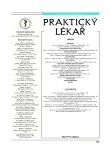Horner’s syndrom: Topical diagnostics of the causative lesion (three case reports)
Authors:
J. Otradovec; P. Diblík; P. Kuthan
Authors‘ workplace:
Oční klinika 1. LF UK a VFN, Praha
přednostka doc. MUDr. B. Kalvodová, CSc.
Published in:
Prakt. Lék. 2005; 85(7): 398-401
Category:
Diagnostis
Overview
In three instructive case reports the authors recall their experience with etiological diagnostics of the causative lesion in Horner’s syndrome:
1. The inborn form of the syndrome found in a 6-week old newborn followed up for 12 years.
2. Anisocoria in Horner’s syndrome diagnosed on oneself by chance by a 60-year old physician fearing an intracerebral aneurysm. The picture was a part of cluster hemicrania and the case report acquainting with its development over the next ten years.
3. In a 50-year old hypertonic patient with amaurosis in one eye upon occlussion of arteria centralis retinae proceded by Horner’s syndrome following a lesion of periarterial n. sympathicus accompanying a sclerotic occlusion of the internal carotic artery. Followed up for ten years.
Key words:
Horner’s syndrome – cluster hemicrania – occlusion of arteria carotis interna – heterochromia of the iris and inborn Horner’s syndrome.
Labels
General practitioner for children and adolescents General practitioner for adultsArticle was published in
General Practitioner

2005 Issue 7
Most read in this issue
- Lemierr’s syndrome
- Horner’s syndrom: Topical diagnostics of the causative lesion (three case reports)
- Q fever: properties of the agent
- Q fever – clinical picture
